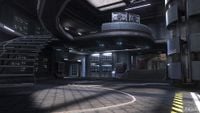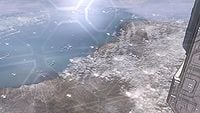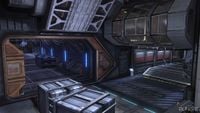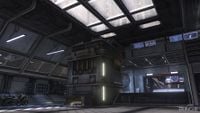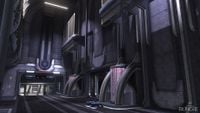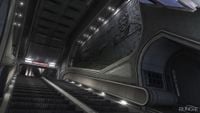Quito Space Tether: Difference between revisions
From Halopedia, the Halo wiki
m (Bot: Automated text replacement (-{{[ ]*[Ll]evelname[ ]*\|[ ]*(.*?)[ ]*}} +\1)) |
Datadeleter (talk | contribs) No edit summary |
||
| Line 24: | Line 24: | ||
==Overview== | ==Overview== | ||
It is used for lifting heavy | It is used for lifting heavy ordnance from the surrounding port facilities into an orbital station at the top of the elevator structure, a transport method much cheaper and more efficient than booster rockets filled with expensive fuel.<ref>'''Game Informer: December 2008''', page 8</ref> As a space elevator would preferably have to be constructed near the equator,<ref>[[Wikipedia:Space elevator|'''Wikipedia''' - ''Space elevator'']]</ref> Quito is an ideal location for such a structure as the city is located only a few kilometers south of the equator.<ref>[[Wikipedia:Quito|'''Wikipedia''' - ''Quito'']]</ref> | ||
Built by the [[International Society of Civil Engineers]], the tether was completed on January 14th, [[2313]] and named on March 9th, [[2401]]. The receiving station at the top of the elevator tether houses a monument dedicated to doctors [[Tobias Fleming Shaw]] and [[Wallace Fujikawa]], the creators of the [[Shaw-Fujikawa Translight Engine]].<ref>'''[[Halo 3]]''', [[multiplayer]] map ''[[Orbital (level)|Orbital]]''</ref> | Built by the [[International Society of Civil Engineers]], the tether was completed on January 14th, [[2313]] and named on March 9th, [[2401]]. The receiving station at the top of the elevator tether houses a monument dedicated to doctors [[Tobias Fleming Shaw]] and [[Wallace Fujikawa]], the creators of the [[Shaw-Fujikawa Translight Engine]].<ref>'''[[Halo 3]]''', [[multiplayer]] map ''[[Orbital (level)|Orbital]]''</ref> | ||
Revision as of 02:41, November 26, 2010
Template:Ratings Template:Base Infobox Template:Article Quote
The Quito Space Tether is a space elevator located on Quito, Earth. As such, it is the second known space elevator in Latin America and one of six elevators on Earth.
Overview
It is used for lifting heavy ordnance from the surrounding port facilities into an orbital station at the top of the elevator structure, a transport method much cheaper and more efficient than booster rockets filled with expensive fuel.[1] As a space elevator would preferably have to be constructed near the equator,[2] Quito is an ideal location for such a structure as the city is located only a few kilometers south of the equator.[3]
Built by the International Society of Civil Engineers, the tether was completed on January 14th, 2313 and named on March 9th, 2401. The receiving station at the top of the elevator tether houses a monument dedicated to doctors Tobias Fleming Shaw and Wallace Fujikawa, the creators of the Shaw-Fujikawa Translight Engine.[4]
The orbital station on top of the tether had at least four gates leading to terminals from which passengers or cargo could be ferried to other UNSC-controlled worlds. During 2552, transports led to remaining UNSC worlds such as Gilgamesh and Ballast, and one to other planets in the Sol System. One flight, to Charybdis IX, had been indefinitely delayed, due to the planet's loss 17 years earlier. The Quito Space Tether was among the four that survived the Battle of Earth.[5]
Trivia
- The Halo 3 multiplayer level named Orbital of the Mythic map pack, takes place on the station on top of the Quito Space Tether.
Gallery
- Quito station plaque.png
A plaque dedicated to the men and women who built the Space Tether, from the International Society of Civil Engineers.
The plaque devoted to Wallace Fujikawa.
The plaque devoted to Tobias Fleming Shaw.
Sources
- ^ Game Informer: December 2008, page 8
- ^ Wikipedia - Space elevator
- ^ Wikipedia - Quito
- ^ Halo 3, multiplayer map Orbital
- ^ Halo Waypoint, Space Elevator article
|
| |||||
